SI Vault: The complex twists of Rondo

Editor's note: This story originally ran in the February 25, 2013, issue of SPORTS ILLUSTRATED. To subscribe, click here.
The toughest man pound-for-pound in the NBA is working on his third Shirley Temple, extra grenadine, as he recovers from the Connect Four incident. Before he landed in Boston, became the Celtics' starting point guard, won a championship, was voted to the All-Star Game, suffered a torn ACL and watched his team play its best basketball of the season without him, Rajon Rondo grew up in a development near downtown Louisville called College Court. His mother allowed him to roam the neighborhood during the day, but she demanded he be home by the time the streetlights flickered on at dusk. Rondo would set up a Connect Four grid on the front porch and play deep into the night, welcoming friends and family members to his stoop, and then dispatching them all. "He beat everybody," says his mom, Amber Rondo. The boy possessed an unearthly ability to see the entire board and think three moves ahead.
When the Celtics drafted Rondo in 2006, they encouraged their first-round pick to ingratiate himself in his new hometown through public appearances and community events. "But I'm not a great people person," Rondo says. In a sports world filled with phonies, sons of the street who sand their jagged edges for mass consumption, Rondo is as real as a rusted rim. He is the ultimate showman, hurling lobs 50 feet in the air during warmups and fielding tip-offs with his forehead, yet he couldn't give a whit about showmanship. Rondo scoffs at the stars who list themselves as game-time decisions with ankle tweaks—"They just want an excuse if they don't play well"—and fumes at the ones who hug opponents as if they're at a Junior League luncheon. "I'm not trying to make friends," he says. "We can talk in the summer." Opposing point guards, weary of Rondo's jawing and jostling, wonder if he is picking a fight with them or simply doesn't like them. "With Rajon," says Celtics power forward Kevin Garnett, "there ain't no f------ around."
The Celtics didn't want to change Rondo when he arrived, but they didn't want to hide him either. So at charity functions he perched behind a folding table where he could avoid the back-slapping, baby-hugging and other standard forms of celebrity fakery. He just played Connect Four, against anybody who dared, usually two grids at a time and sometimes three. "This has been going on for six years," Matt Meyersohn, the Celtics' director of community relations, said on Dec. 22 during an event at the Blue Hill Boys & Girls Club in Dorchester, Mass. "He's played hundreds of Connect Four games, maybe a thousand. And he's never lost."
Later that day Rondo sat behind a table and three grids. Across from him were more than 100 children he had showered with bikes, Razor scooters and iPod Touches that he bought at Target and distributed from the back of a U-Haul. "I thought he might let us win," said a 12-year-old named Olisa. "But he was so serious." Rondo wore the requisite Santa hat with jolly red shoes, but through 22 consecutive victories he barely uttered a word or cracked a smile. He held each disk aloft for a solid 10 seconds before depositing it in his chosen column. He stared the kids down as if they were Knicks.
SI.com's top 10 NBA features of 2015
Olisa was the last challenger. He stared back at Rondo through wire-rimmed glasses. He clenched teeth covered with braces. He initiated what he called a trap, forcing Rondo to the right side of the grid, putting him on the defensive. When Olisa dropped the winning disk, Celtics officials started to shout. Meyersohn grabbed the microphone. "This has never happened!" he bellowed. Olisa rushed around the table to take a picture with the shell-shocked champion, who tried to curl up a corner of his mouth for the camera but instead bowed his head, resulting in a snapshot of his scalp.
Two hours later, hopped up on grenadine over lunch at a sushi restaurant in Boston's Back Bay, Rondo looked as if he were still digesting a piece of bad shrimp tempura. "I can't believe it," he said. "But did you notice I played the guy five more times and won them all? I had to show him, 'You beat me, but I'll beat the s--- out of you.'"
*****
On Jan. 25 in Atlanta, Rondo played 45 minutes and two overtimes against the Hawks, despite picking up what he believed was a tweaked right hamstring. Two days later, at the shootaround before a game against the Heat, Rondo was still icing the hamstring when Celtics doctor Brian McKeon felt Rondo's right knee and sent him to New England Baptist Hospital for an MRI. Just as Chicago's Derrick Rose was rehabbing his torn ACL, another mesmerizing young ballhandler was felled by the same injury, at a critical juncture in his career.
Rondo, 27, was averaging 13.7 points and 11.1 assists—nobody else in the NBA even cracks double figures in assists—while shooting 48.4%, fourth among guards, stunning considering teams used to leave him open at the free throw line. Rondo has a complicated relationship with the basket ("A lot of times I'll be shooting and think, Maybe I should pass"), but he was up to 48% from 16 to 23 feet, according to hoopdata.com, compared to 39% last season. The Celtics always wondered what Rondo could accomplish if he burned those sagging defenses, and after dozens of fruitless sessions with shot doctors, he was curing his jumper thanks to one simple piece of advice from New York's Jason Kidd: "If you're going to shoot, you need to have your mind made up that you're going to do it." Rondo was due to start in the All-Star Game for the first time, an honor he took so seriously that he declined to pose for a picture in the uniform, for fear of jinxing himself.
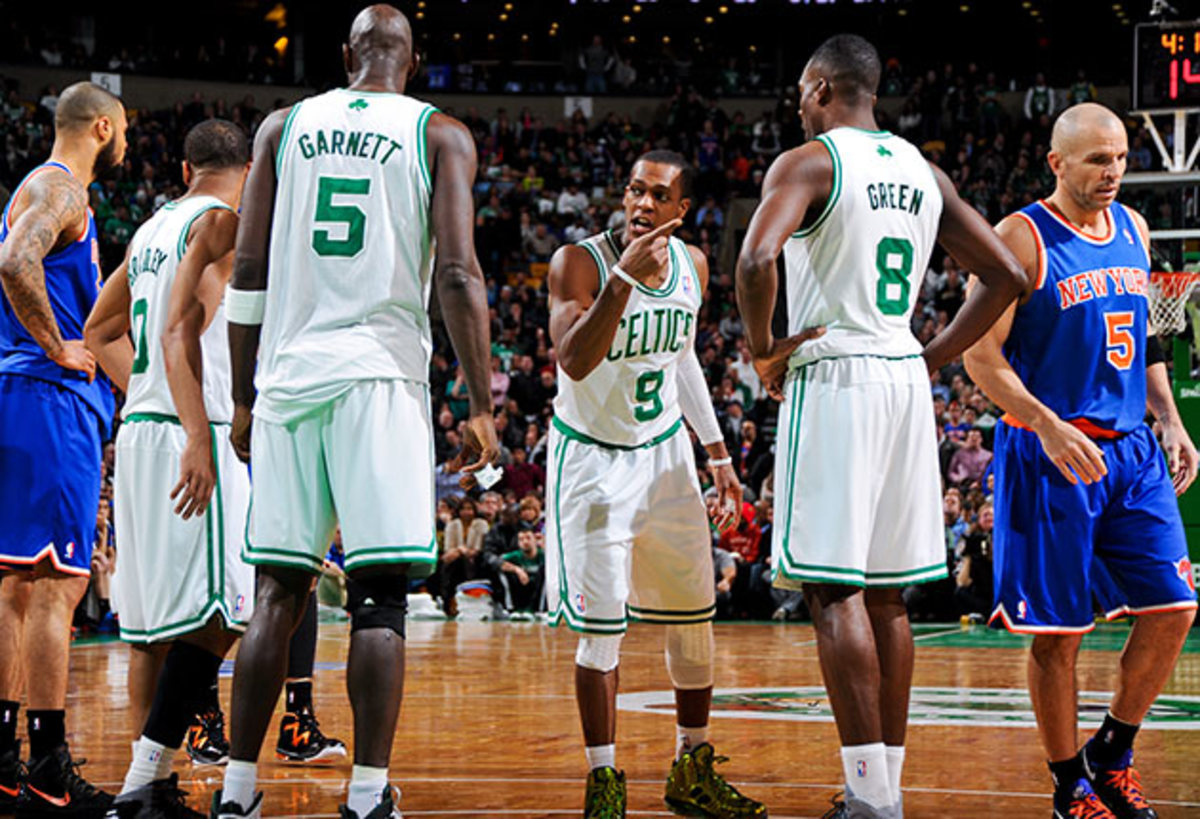
averaging more than seven assists. Rondo has declined interviews since he hobbled out of TD Garden on Jan. 27 and has been following the team from home, but there's no way he is missing the irony: Boston lost the best passer in the league and the fastest runner on the roster, yet its ball movement improved and so did its pace. The team was averaging 14.97 transition possessions per 48 minutes before Rondo's injury, according to Synergy Sports, and 15.26 during the streak after it. Of course, the Celtics are not better without Rondo, and come spring they will be reminded why. Over the past three years he has been their most reliable playoff performer and their strongest rebuttal to Miami. How quickly one forgets the 44 points, 10 assists and eight rebounds he hung on the Heat in Game 2 of the Eastern Conference finals.
Given Rondo's affection for national television (21 of his 28 triple doubles have come on the big broadcasts), Nike should film his rehab like Adidas did with Rose. A torn ACL used to require at least a full year of recovery, but 48 hours after the diagnosis Boston general manager Danny Ainge declared that he expected Rondo "back and as good as ever in training camp." Ainge cited Vikings running back Adrian Peterson, who embarked on a 2,000-yard season less than nine months after ACL surgery, and former Celtics center Kendrick Perkins, who returned to the court only seven months after the procedure. Ainge's projection was based partly on technology—the operation has grown more sophisticated while the rehab has become more streamlined—and partly on psychology. "The Peterson type, the Rose type, the Rondo type, these are perfectionists with a meticulous approach to everything they do," says Kevin Wilk, clinical director for Champion Sports Medicine, who oversees physical therapy for patients of Dr. James Andrews, the surgeon who performed Rondo's operation. "If guys like that are doing 10 reps, and the eighth isn't right, they'll start over where someone else will stop. They won't ever shut it down."
Rondo was not raised on basketball, nearly quit the sport in high school and entered the NBA as a third-stringer. He is 6'1" and 186 pounds, waifish compared with muscled peers such as Rose, and still reluctant to shoot. He has never played in a transition offense or partnered with a premier roll man, yet he has racked up assist averages over the past two seasons not seen since Magic Johnson and John Stockton while snagging rebounds as if he were six inches taller. Some of his stat lines—like his 16-point, 14-assist, 13-rebound game against the 76ers on Dec. 7—appear to have never before been printed in a box score. "There's no one in the history of our game like him," says former forward Brian Scalabrine, who spent four seasons with Rondo in Boston. "He's the most interesting player I've ever known. How does someone who is 6'1" get 18 rebounds? How does someone who doesn't run fast break get 20 assists? How does someone who never shoots get everybody open? We cannot begin to understand how he does it."
Amber considered calling him Roderick, after an uncle. William, his oldest brother, preferred Johnny. They settled on Rajon, a name that would be butchered by a hundred broadcasters. RAH-zhan was born at University of Louisville Hospital in 1986, and before his mother laid eyes on the baby boy with the narrow cheekbones, a doctor approached in awe. "His hands," the obstetrician gushed, "are humongous."
The Fundamentals: Blazers reinvent old offensive system with new parts
Twenty years later, when Rondo was coming out of Kentucky after two seasons, the Celtics prepared a scouting report on him that referred to what Ainge called "freak factors." Rondo's hands, 9½ inches long and 10 inches wide, are the size of a 7-footer's. His wingspan is 6'9", common for a power forward. If built proportionally, he says, "I'd be like Magic or Oscar Robertson." In peripheral vision tests Rondo beats everybody except Ainge, and on road trips he can recall exact directions to places he visited once. Ainge has seen him throw a football 80 yards, hit a softball 380 feet and beat 33-year-old assistant general manager Ryan McDonough in a 40-yard dash with a tire strapped to his waist. In college Rondo stole the ball from his man 16% of the time; no one else in the 2006 draft swiped it more than 5%.
For a pure point guard, a term polluted by a generation of gunners, there is little difference between basketball and Connect Four. Disks on a grid are like players on a court, pieces to move, forming angles to exploit. If Rose is a dervish, Rondo is a strategist, turning down open layups for more-open three-pointers, repositioning one teammate to make room for another, taking an extra glide step on a pick-and-roll so an older big man can work free. He cradles the ball in his suction-cup palms, pointing it left and right, wrapping it around his head and waist, shifting the defense with every sleight of hand. Each pump fake and sideways glance is designed to create an extra inch of space. Rondo passes with flamboyance and disdain, spiking the ball off the floor or firing it through a mob, and he finishes with more English than a pool shark. His floaters are high enough to hit the shot clock. "If you're not careful," says former Bucks coach Scott Skiles, "you get paralyzed watching him."
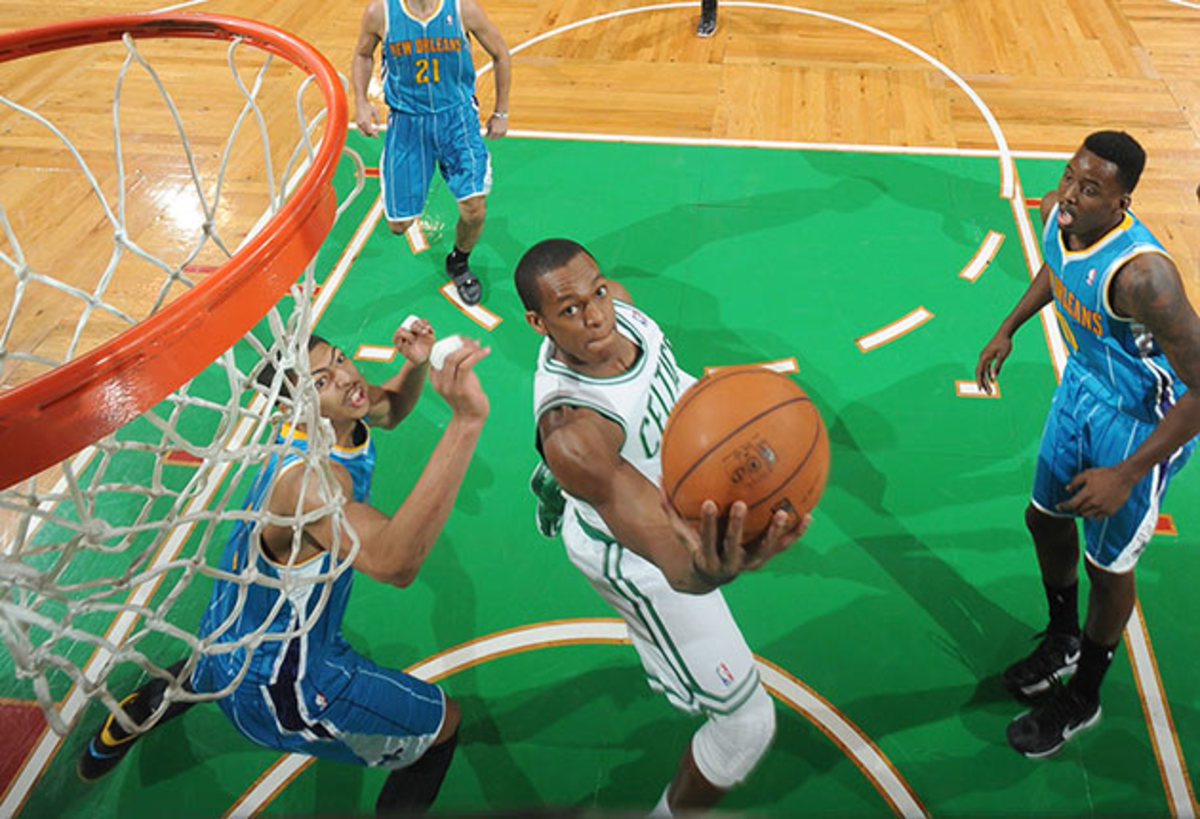
for a corner three last year at Golden State—he closes his eyes. "It was a risky play," he says, "but I'm a risky player." Young Celtics joke about times they've been hit in the head with Rondo no-looks. "I don't hit them in the head," Rondo clarifies. "I hit them in the face."
Rondo's style, creative and eccentric, is an expression of his personality. "Everybody wants to score, score, score," he says. "So I want to pass. I like to be different. I could never be a follower." When he was a boy, his friends wore Air Jordan sneakers, which forced him into Air Max. Even now, when the Celtics work out in green shirts, he chooses white. Coaches traditionally instruct players to shoot with their left hand on the left side of the rim, but Rondo uses his right, limiting exposure to the ball. In November he surprised an algebra class at Jeremiah E. Burke High School in Dorchester, and wound up giving an impromptu lesson. The teacher told him he solved equations in a way she had never seen before.
Rondo takes five showers on game days, the last one precisely 45 minutes before tip-off, because he does his best thinking in the water. He jumps out to scribble ideas, which can present problems, since he is a germaphobe who hates being barefoot. He keeps three or four pairs of shower shoes in his locker. "I'm a little OCD," he admits. He guzzles five bottles of water on the drive to the arena so he doesn't have to bother with Gatorade cups on the bench, and he tucks a tube of Carmex in his sock to keep his lips hydrated. The company sends hundreds of refills before each season, helpful considering how many teammates ask for a dollop. Rondo dispenses it on their fingertips. His routine is carefully choreographed, from the sky-scraping lob he launches in pregame layup lines to the opening dribble off his head or chest or knee. Garnett used to corral the tip from Perkins and hike it between his legs to Rondo. Then the Celtics traded Perkins to Oklahoma City, where he hikes to Russell Westbrook. Rondo winces at the thought. "It still seems like we're trying to replace Perk," he says.
He maintains 3.5% body fat, even though he spreads entire cubes of butter on pieces of bread, and he eschews heavy weightlifting because he fears it will compromise his quickness. Rondo spends most of his free time playing cornhole, a game typically reserved for frat boys at Big Ten tailgate parties. He owns two wooden boards, emblazoned with Kentucky and Louisville logos, which he spaces 27 feet apart in his front yard, according to the official rules. He installed a fire pit so he can play through the winter with his neighbor, a thirtysomething Boston businessman who has become equally consumed with tossing beanbags into circular holes. Rondo is thinking of entering national cornhole tournaments. "I'm ranked Number 1," he says. He is kidding, but you have to ask to make sure. He does nothing for amusement.
After a December practice in Chicago, Rondo played one-on-one with Celtics guard Courtney Lee and scored the first eight baskets. "Now we'll get serious," Lee said. Rondo was incredulous. "Isn't it always serious?" he asked. Rondo and Lee also played two-on-two at full speed, less than three hours before games. "It starts fun," Lee says. "Then it gets personal." When Rondo was ejected on Nov. 28 for pushing the Nets' Kris Humphries after a hard foul on Garnett, which snapped Rondo's streak of 37 games with 10 or more assists, his high school coach asked why he'd jeopardize such a historic run. "I don't give a damn about that," Rondo replied. He explained that Brooklyn players were calling Boston soft before the game, loud enough to hear in the locker room across the hall. "I wasn't looking to fight," Rondo told the coach, Doug Bibby. "I had no choice."
Teammates encourage Rondo to take up poker in addition to cornhole because he wears the same flat gaze whether celebrating or seething. He can throw a no-look alley-oop over his head from the three-point line, as he did to a giggling Kenneth Faried at an exhibition game during the 2011 lockout, or miss a midrange jumper when no one is within 10 feet of him, and he responds with neither smile nor scowl, leaving the world to wonder what is brewing inside and when it will come spilling out. "He's a volcano," says Boston coach Doc Rivers. "But I'd rather a volcano that can erupt than one that's extinct."
In the early 1990s the trauma center staff at University of Louisville Hospital knew Rajon Rondo by name. To keep up with his older brothers, William and Anton, he ran into a mailbox and a light post, fell off a street sign and a scooter, and cut his leg to the bone on a four-foot boulder. His father left when he was in elementary school—"That's why I don't trust a lot of people," he says—and his mother grew so weary of his insubordination that she drove him to Home of the Innocents, a refuge for troubled children. As part of an elaborate plot, she asked the director to meet them at the front door with paperwork. "I was scared to death," Rondo says. "She was done with my a--."
Instead of sending him away, Amber bought him the only hoop in College Court, to replace the milk crate he had hung in the backyard. Rondo preferred football and baseball to basketball. He didn't watch the NBA. He didn't study the greats, but somehow their moves—from the Euro-step to the Dream Shake—found their way into his game on the playground. His feel for the sport was innate. He joined the basketball team at Eastern High because Bibby liked his cousin, and as a freshman he was suspended 12 of 24 games for a variety of offenses. He sulked through practices and finished last in wind sprints. He also slept in class, didn't complete his homework and forgot his books. "He was a terrible student," says Bibby, "but he was smart as hell."
Bibby taught math, and after Rondo aced the first few tests, Bibby assumed he was cheating. So Bibby made up special tests for Rondo, but he aced those too. Once, Rondo was dozing while Bibby scrawled a geometry problem on the chalkboard. When Bibby called on him, Rondo woke up, rubbed his eyes and blurted an answer. "Don't be an a------," Bibby muttered. Then Bibby finished the problem and found that Rondo was right. He still gave him a D.
Their dynamic was no different on the court, where Bibby would call for one defense and Rondo would demand another. Bibby once yelled at Rondo, "I broke down film three times last night so I know what I'm talking about!" Rondo replied, "I'm on the damn floor and you're not!" Bibby's cousin Mike was an NBA star. His uncle Henry also played in the league and was a major-college coach. "You're like, 'Why is this little a------ questioning me?'" Bibby says. "His tongue sometimes cuts like a knife. But then you listen to him and you realize he actually does see more than the camera."
GALLERY: Rare photos of Rajon Rondo over the years
Rare Photos of Rajon Rondo
Rajon Rondo
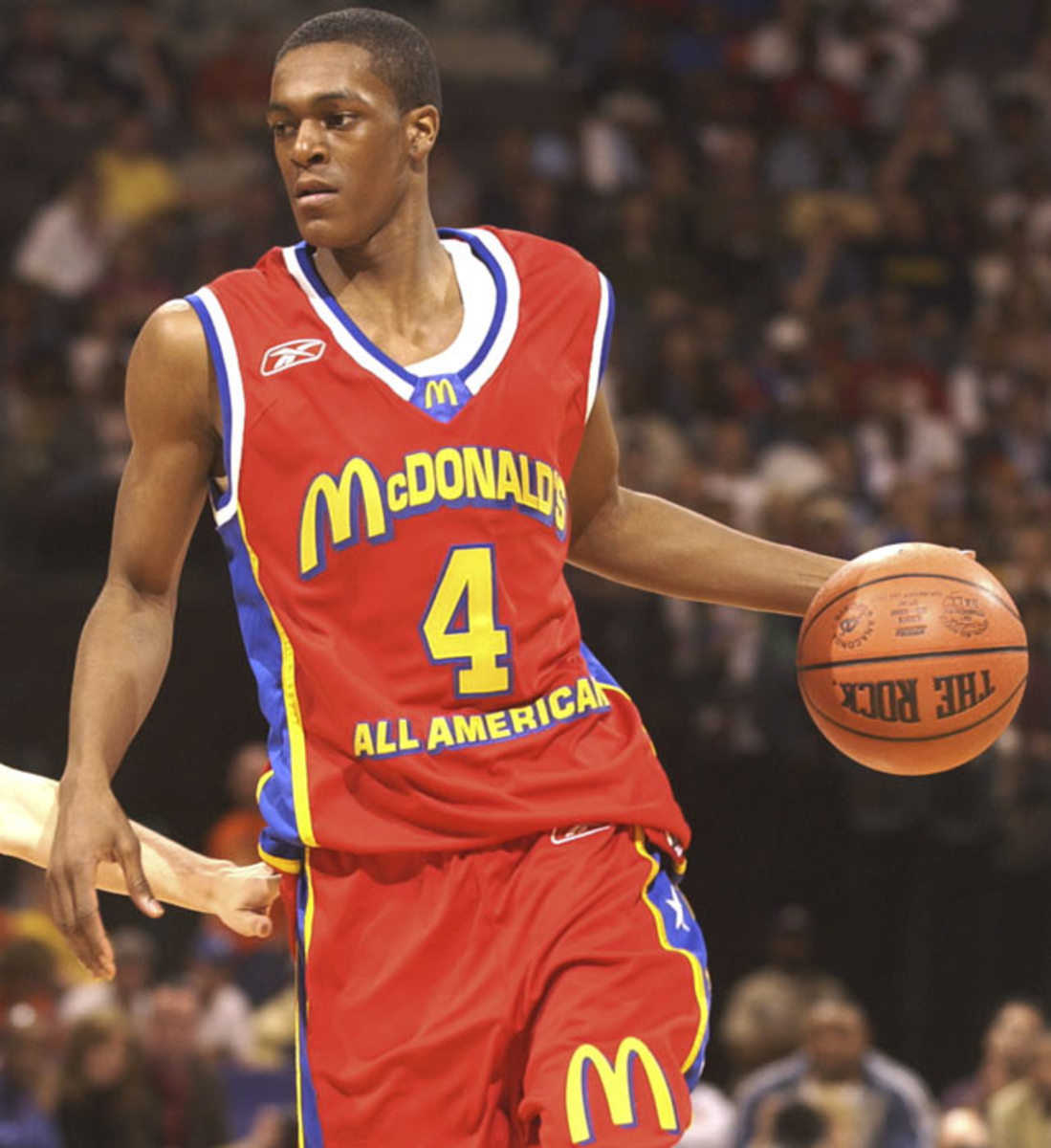
Rondo was born in in Louisville, Ky., and attended Eastern High, where he played under coach Doug Bibby. He transferred to Chicago's Oak Hill Academy, where he averaged 21 points, three rebounds and 12 assists per game. He also played in the 2004 McDonald's All-America game with other top high school talent.
Rajon Rondo

Rondo decided to attend Kentucky instead of hometown Louisville. He was named to the SEC All-Freshman team and set a school record for most assists in a season (87). He finished his freshman year averaging eight points, three rebounds and four assists per contest.
Tubby Smith and Rajon Rondo
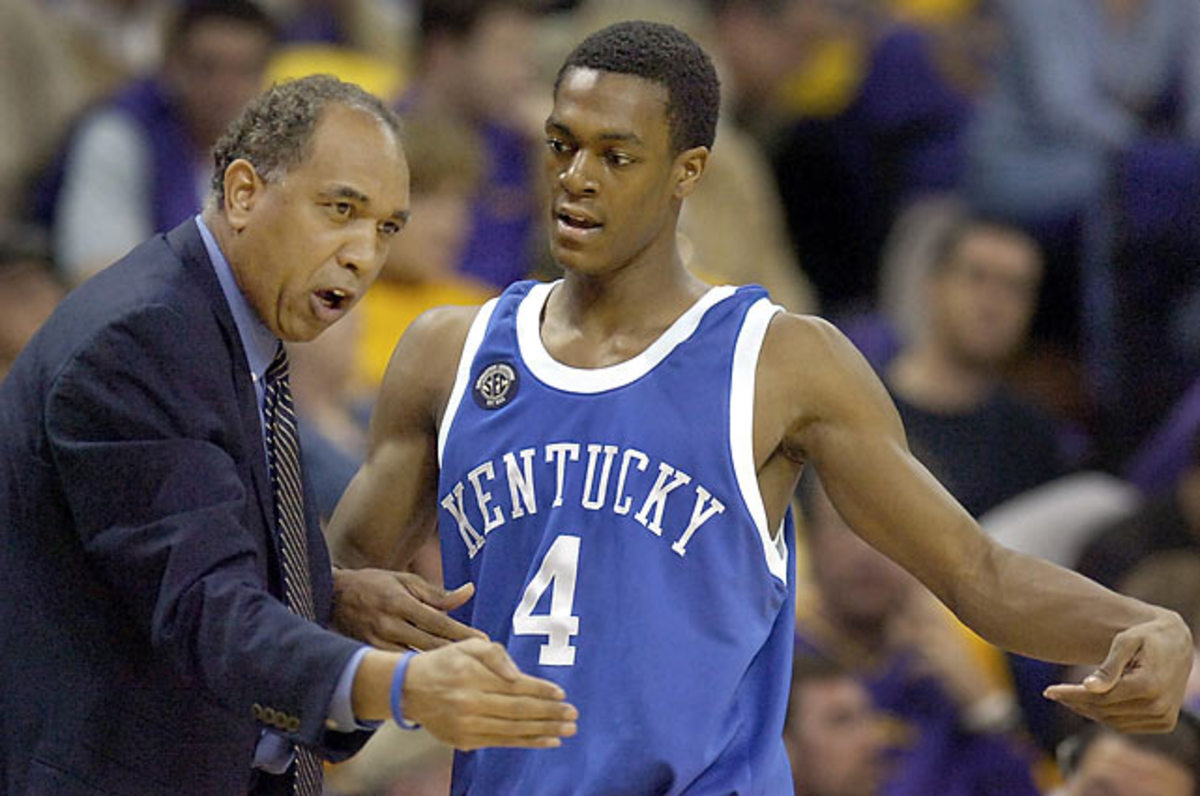
Despite his success at Kentucky, Rondo often clashed with coach Tubby Smith, who wanted Rondo to play a more controlled style of point guard.
Rajon Rondo
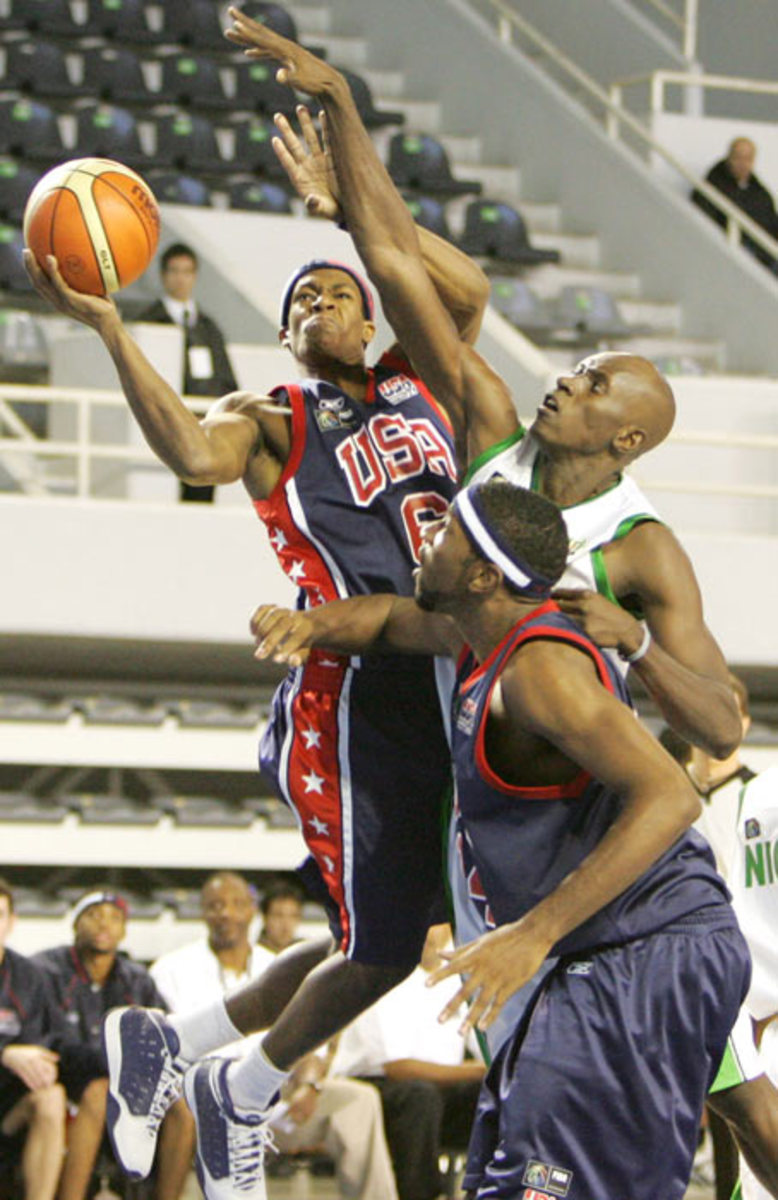
In 2005, Rondo played for the USA Men's Under-21 World Championship Team. The point guard averaged 11 points and five assists per game in the eight-game tournament.
Jason Kidd and Rajon Rondo
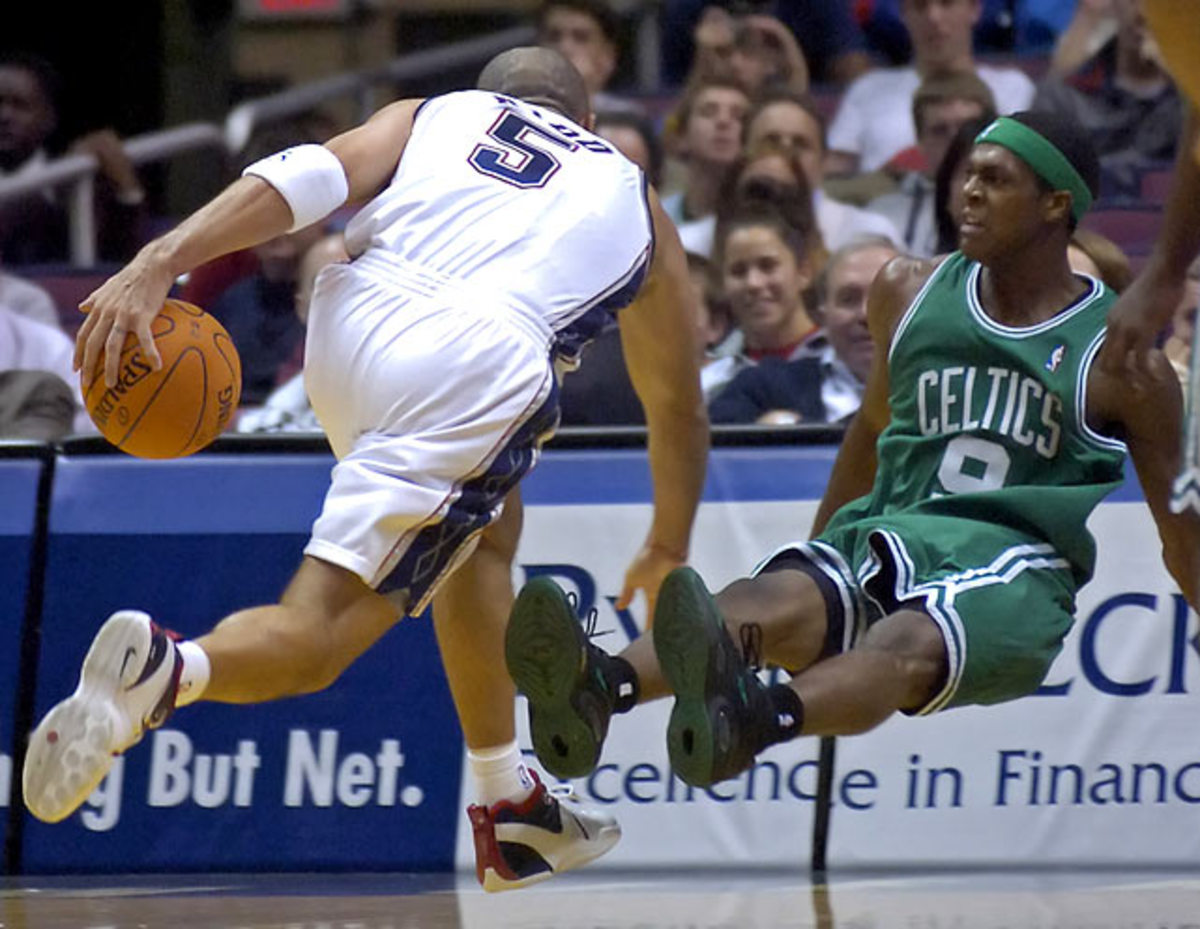
Phoenix took Rondo with the 21st pick in the 2006 draft and immediately shipped him to Boston in a cost-cutting move. He was forced into backup duty his first season behind Sebastian Telfair but wound up starting 25 games for the Celtics. He finished the season averaging six points and four assists per game, good enough for a spot on the All-Rookie Second Team.
Kendrick Perkins, Sam Cassell, Rajon Rondo, Paul Pierce and Kevin Garnett
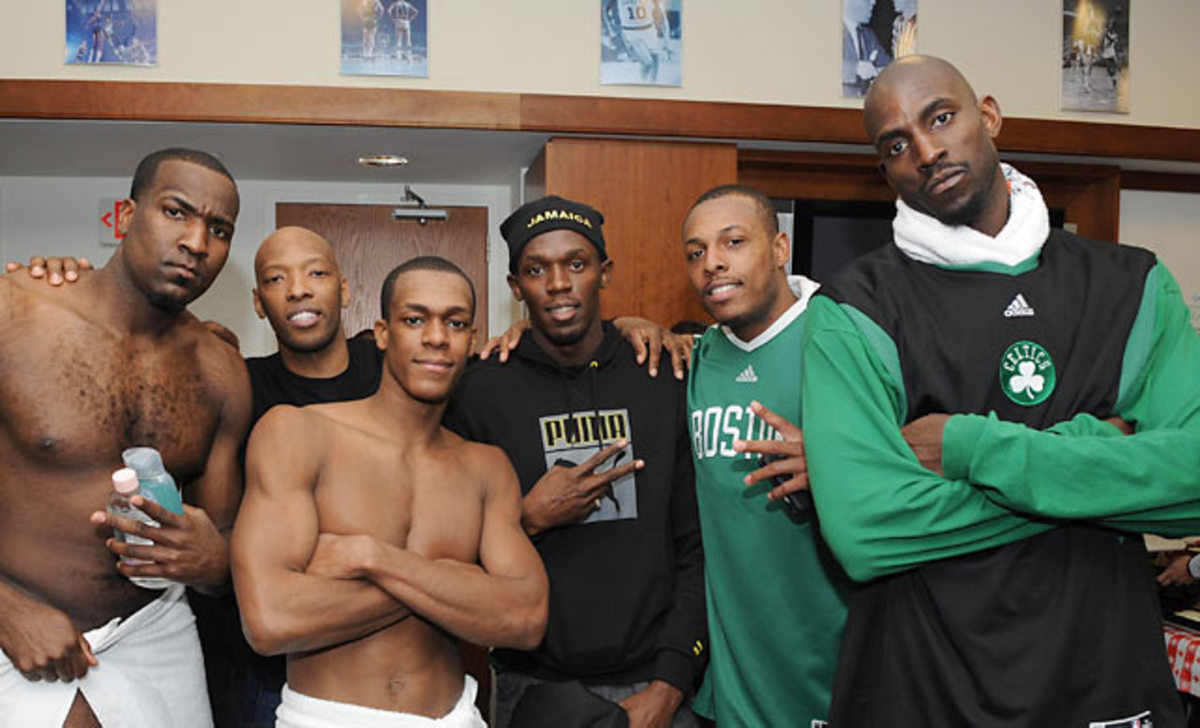
Rondo's career took a drastic turn during the summer before his second season as the Celtics acquired veterans Kevin Garnett and Ray Allen and shipped off guards Delonte West and Sebastian Telfair. Celtics' GM Danny Ainge refused to include Rondo in any trade, feeling he was too talented.
Kevin Garnett and Rajon Rondo
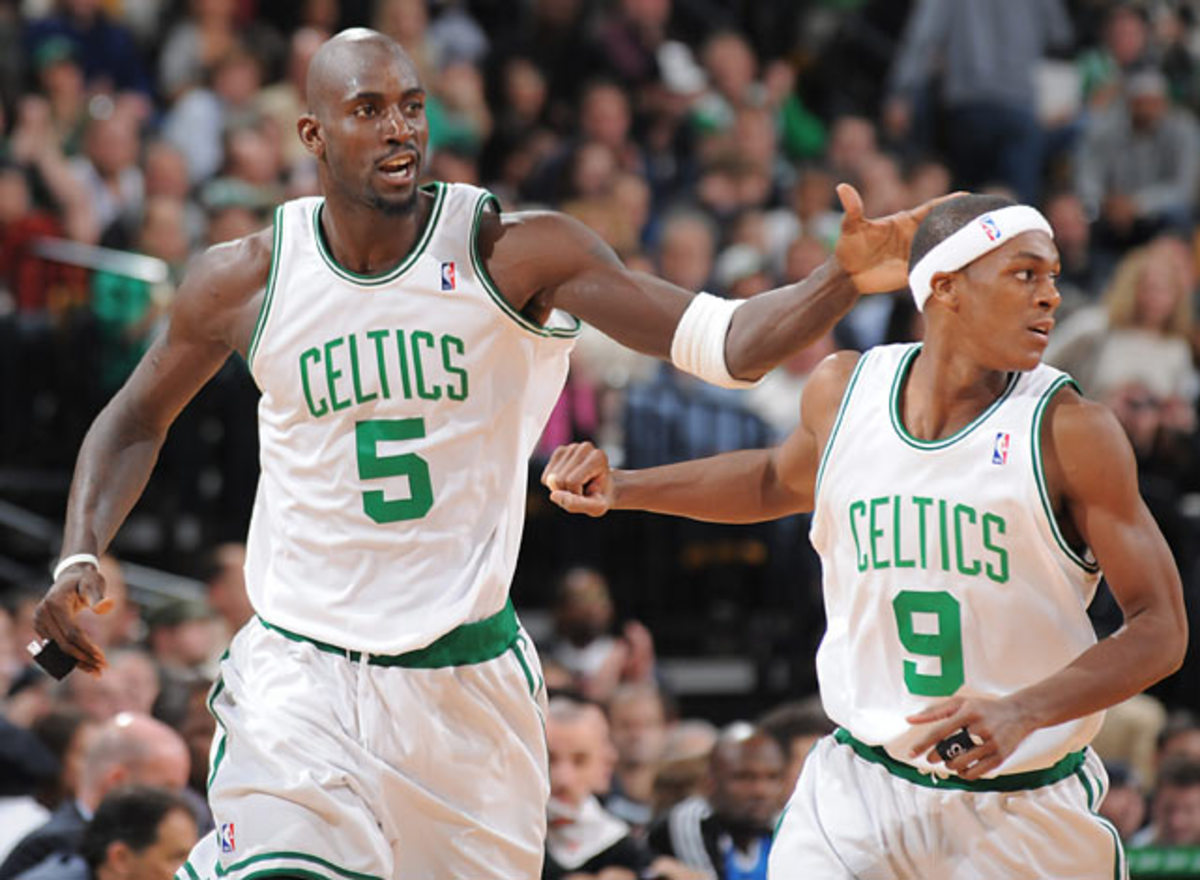
Rondo formed a quick bond with power forward Kevin Garnett as the Celtics raced to a 26-3 record in the first two months of the season.
Rajon Rondo and Marvin Williams
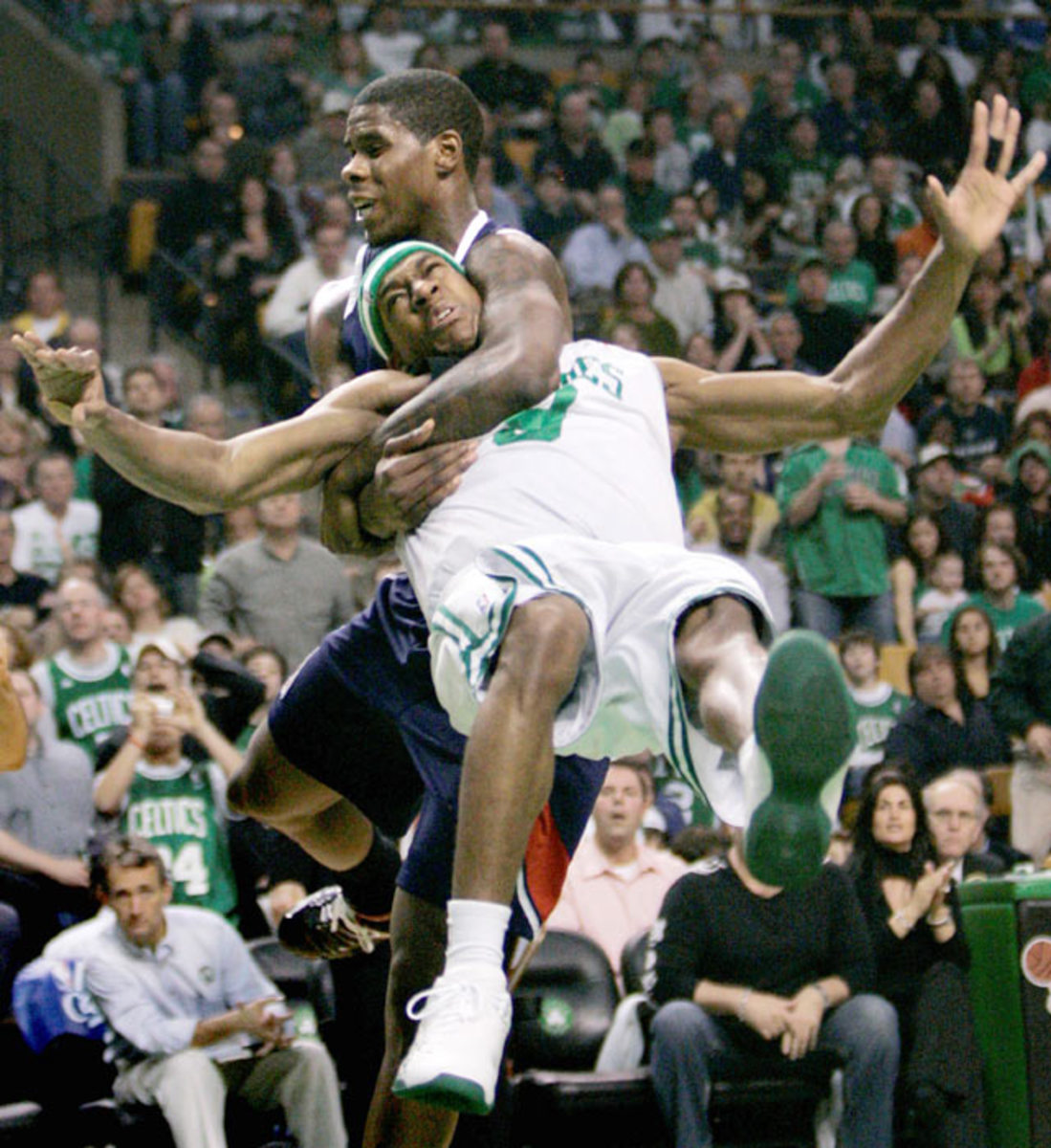
Rondo is tackled by Hawks forward Marvin Williams on a drive to the basket during Game 7 of their first-round playoff series. Williams was ejected on the play as the Celtics rolled to a 99-65 victory.
Rajon Rondo

Boston's new Big Three of Pierce, Allen and Garnett led the Celtics to the 2007-08 NBA championship. Rondo averaged 11 points, five assists and four rebounds per game and finished in the top five for Most Improved Player. In this photo, Rondo tips home a shot during the Finals against the Lakers.
Rajon Rondo

Rondo celebrates the championship during a Duck Boat tour through Boston.
Doc Rivers and Rajon Rondo
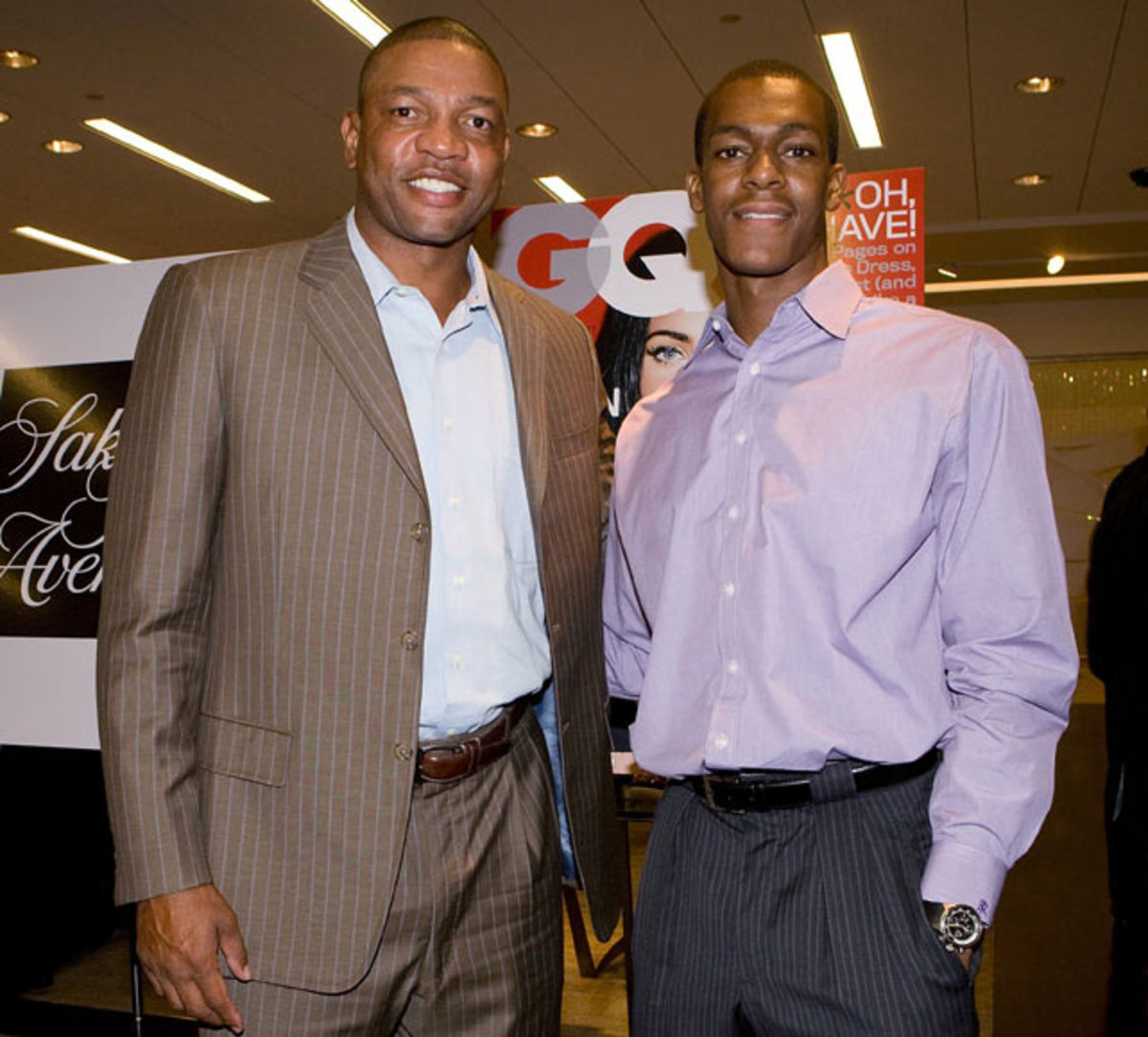
Rondo and Celtics coach Doc Rivers attend an event at Saks Fifth Avenue in Boston.
Rajon Rondo and guest
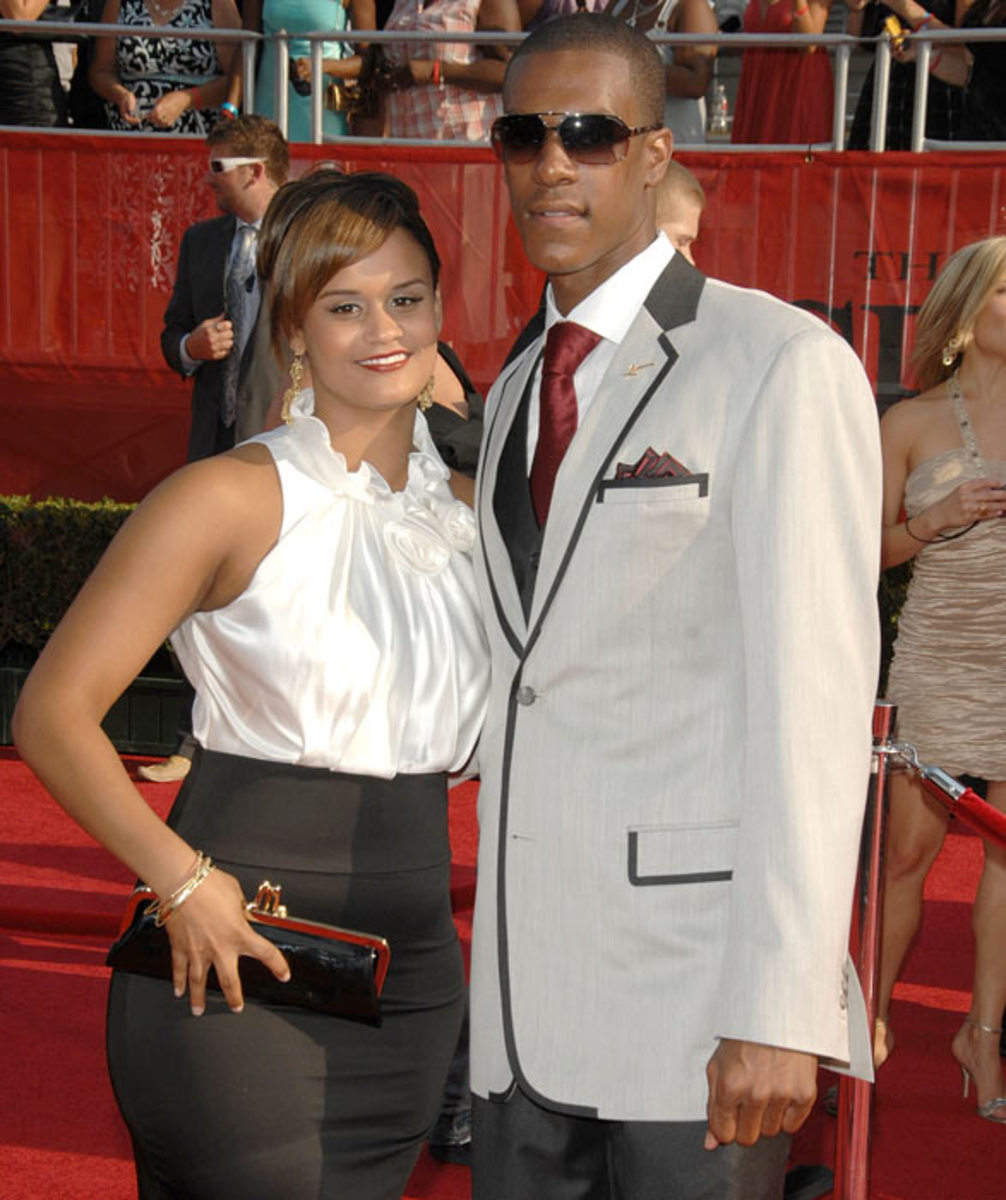
Rondo and a guest arrive at the 2008 ESPY Awards in Los Angeles. The Celtics would go on to win the award for best team.
Rajon Rondo

Off the court, Rondo has picked up roller skating as a hobby. "I'm the best skater in the [NBA]," Rondo told the Boston Globe in 2008. "I don't know who's good, but I'm the best skater in the league. That's just something I like to do outside the court. A lot of us like to bowl, too, but I'd rather skate. I'm in my own zone."
Rajon Rondo and Armond Hill
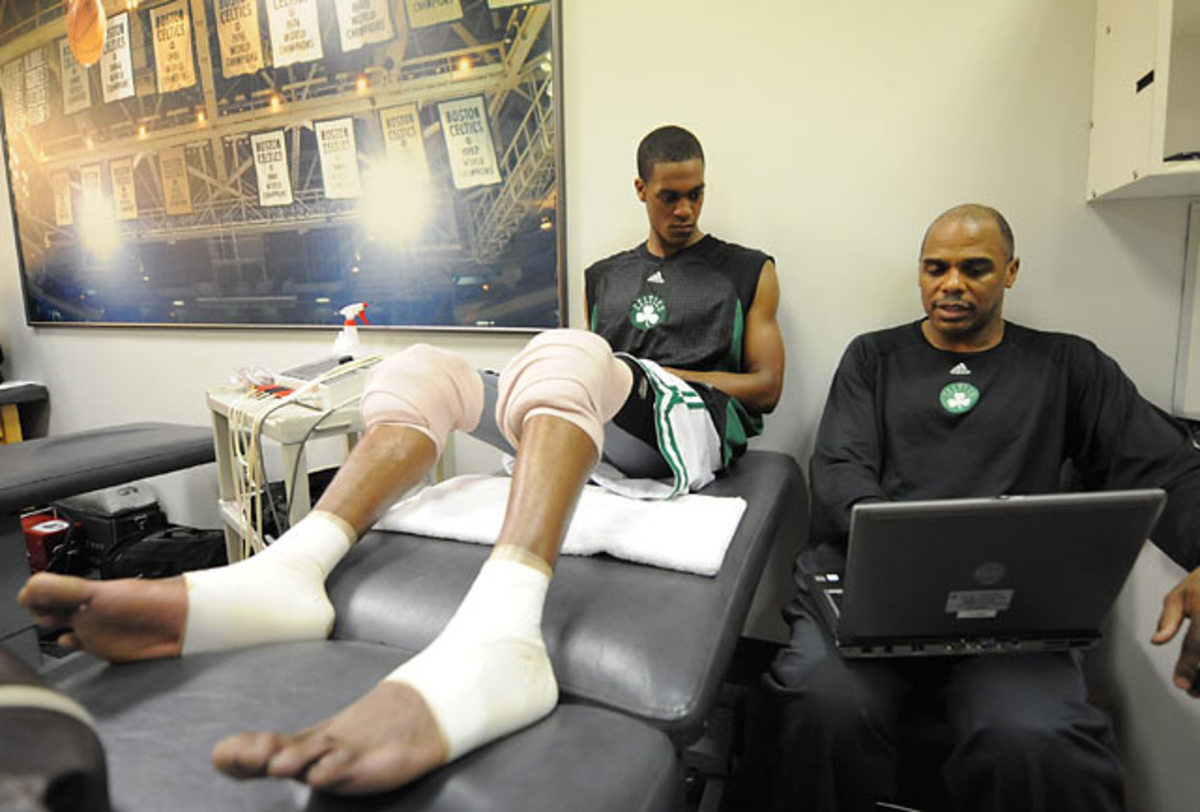
Rondo looks over plays with assistant coach Armond Hill before a game.
Sophomore Team
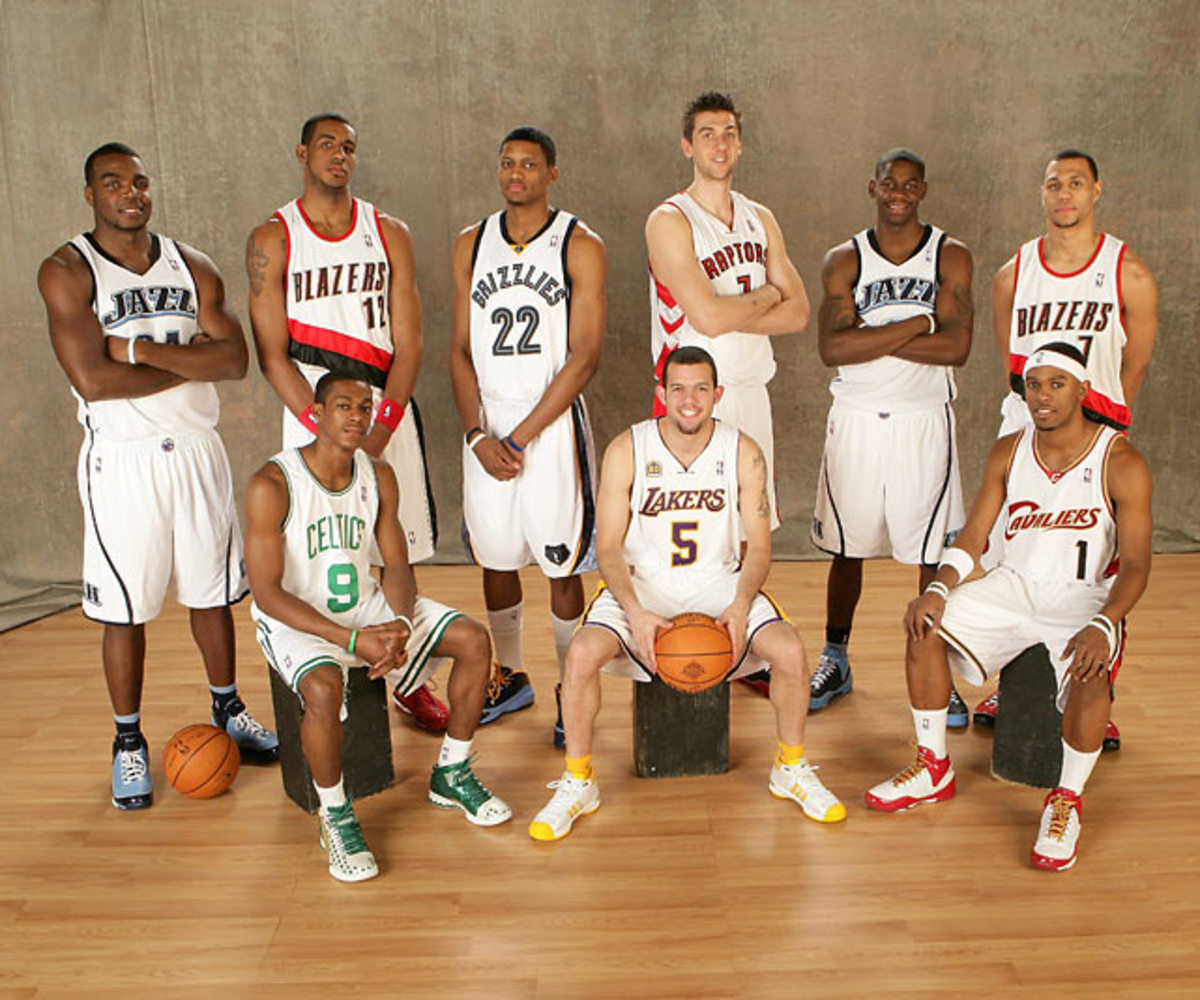
Rondo poses with fellow sophomores Paul Millsap, LaMarcus Aldridge, Rudy Gay, Andrea Bargnani, Ronnie Brewer, Brandon Roy, Jordan Farmar and Daniel Gibson prior to the annual rookie-sophomore game at All-Star weekend. The second-year players would go on to take a 136-109 victory.
Rajon Rondo and Chris Paul
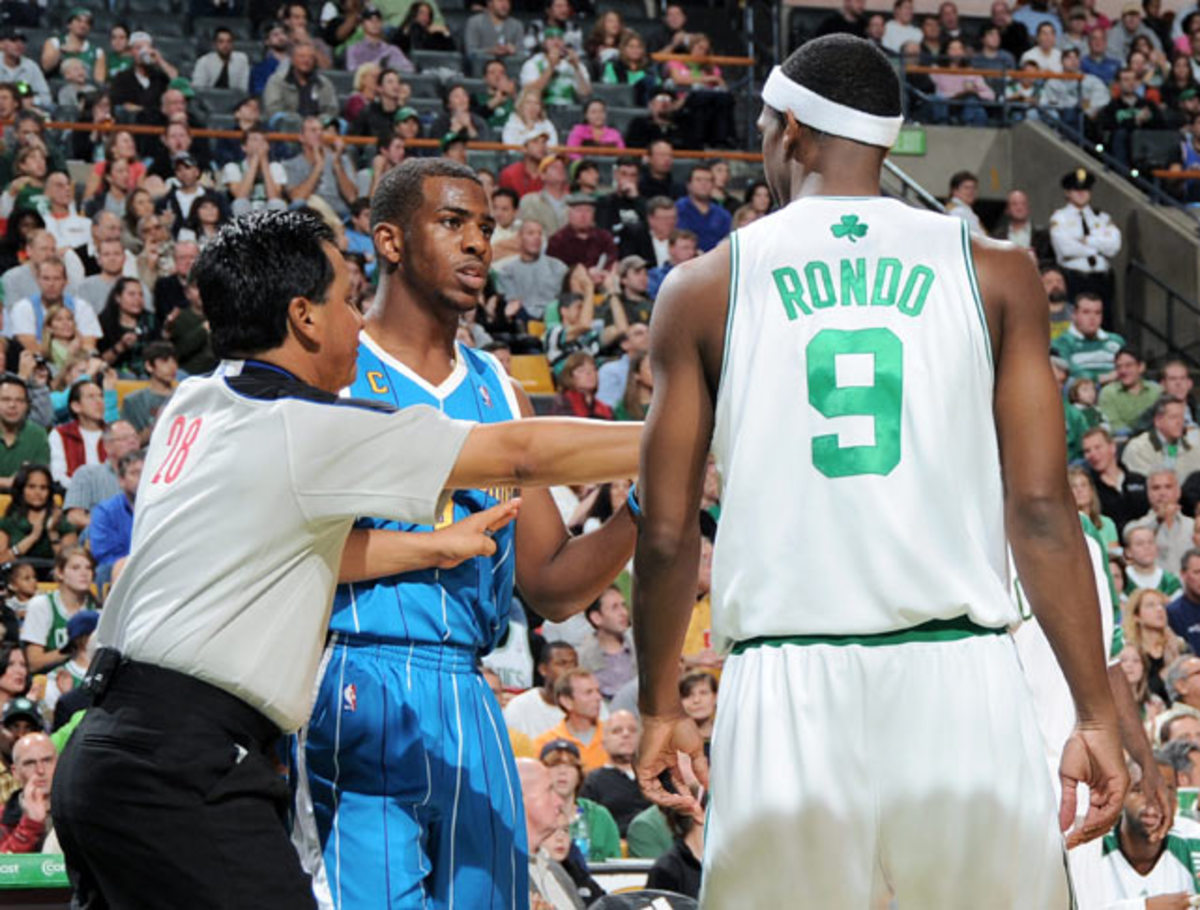
Rondo and Chris Paul exchange words during an early-season matchup. The two -- along with Deron Williams and Derek Rose -- are considered the best young point guards in the NBA.
Rajon Rondo

Rondo spends an August night away from the court, attending Power Balance Goes "All-In For A Cure" at Drai's Hollywood.
Shaquille O'Neal, Nate Robinson and Rajon Rondo
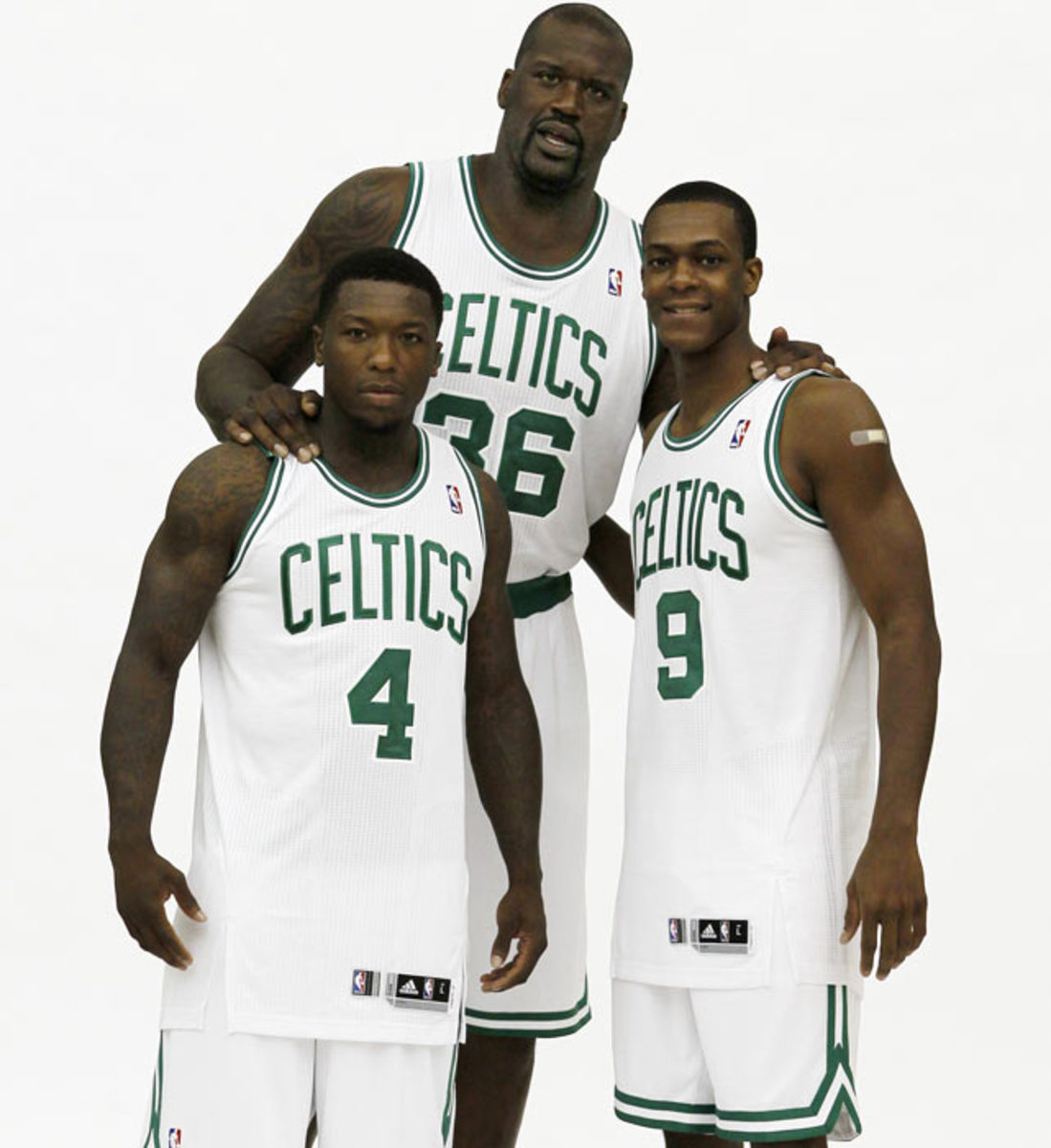
Rondo with Shaquille O'Neal and Nate Robinson at Celtics Media Day. Shaq joined the squad during the offseason and Robinson was brought in via trade late in the 2009-10 season.
Rajon Rondo and Doc Rivers
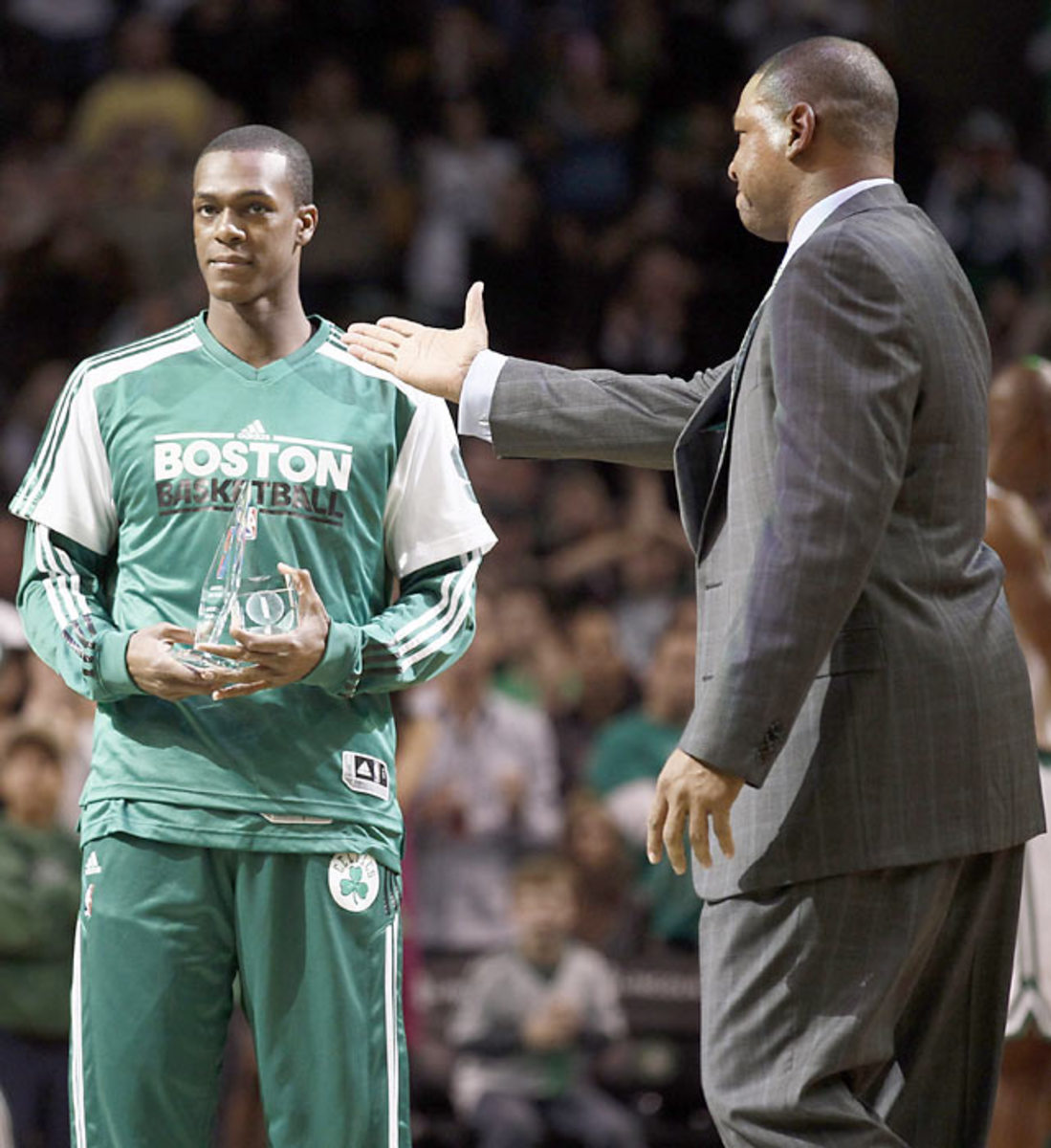
Celtics coach Doc Rivers presents Rondo with awards for leading the league in steals and being named to the all-defensive team.
Rajon Rondo and Derrick Rose
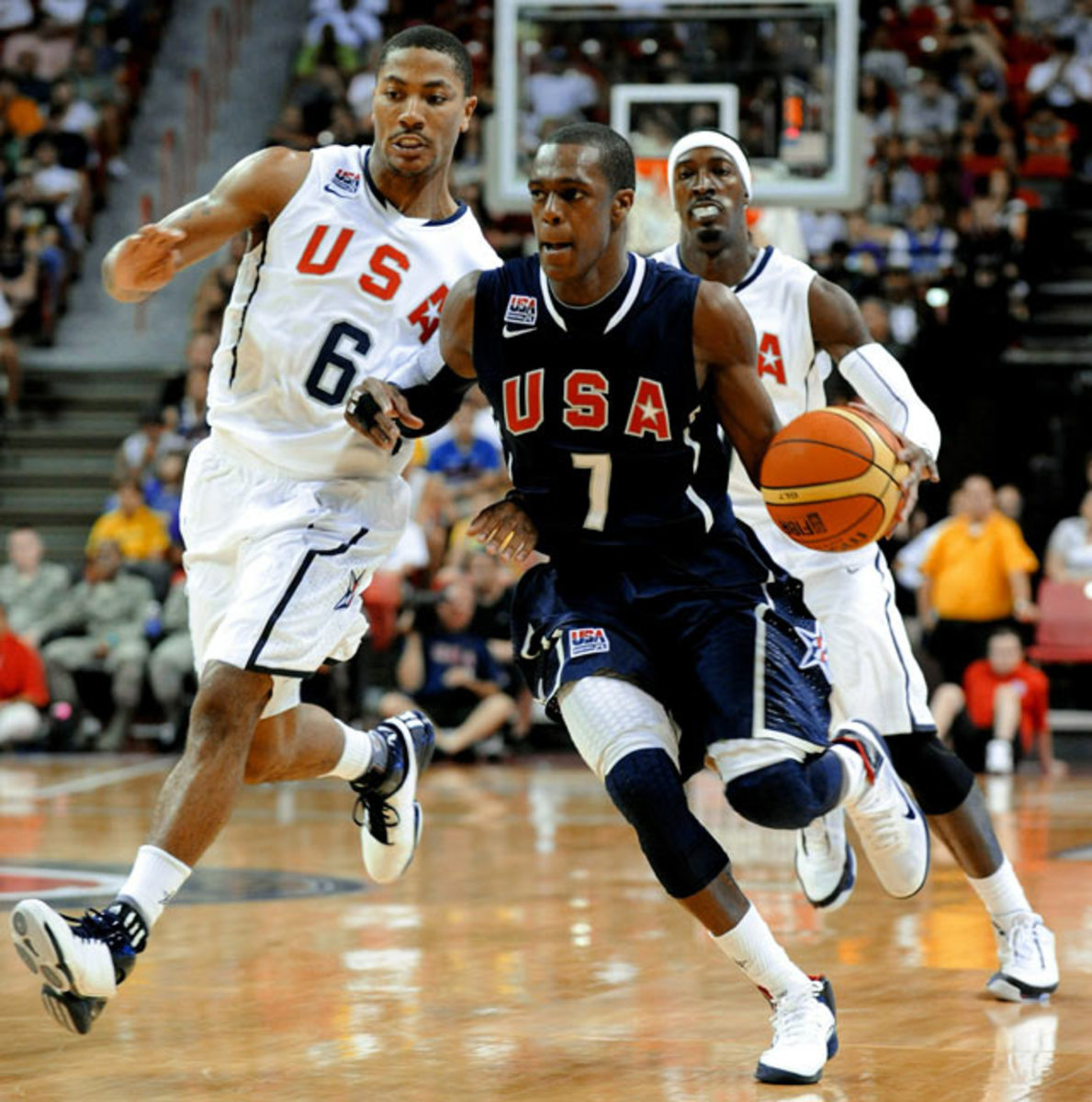
Rondo dribbles past Derrick Rose and Gerald Wallace during a USA Basketball showcase in Las Vegas last summer. Rondo was on the bubble to make the roster and withdrew before final cuts were made.
Rajon Rondo and Kendrick Perkins
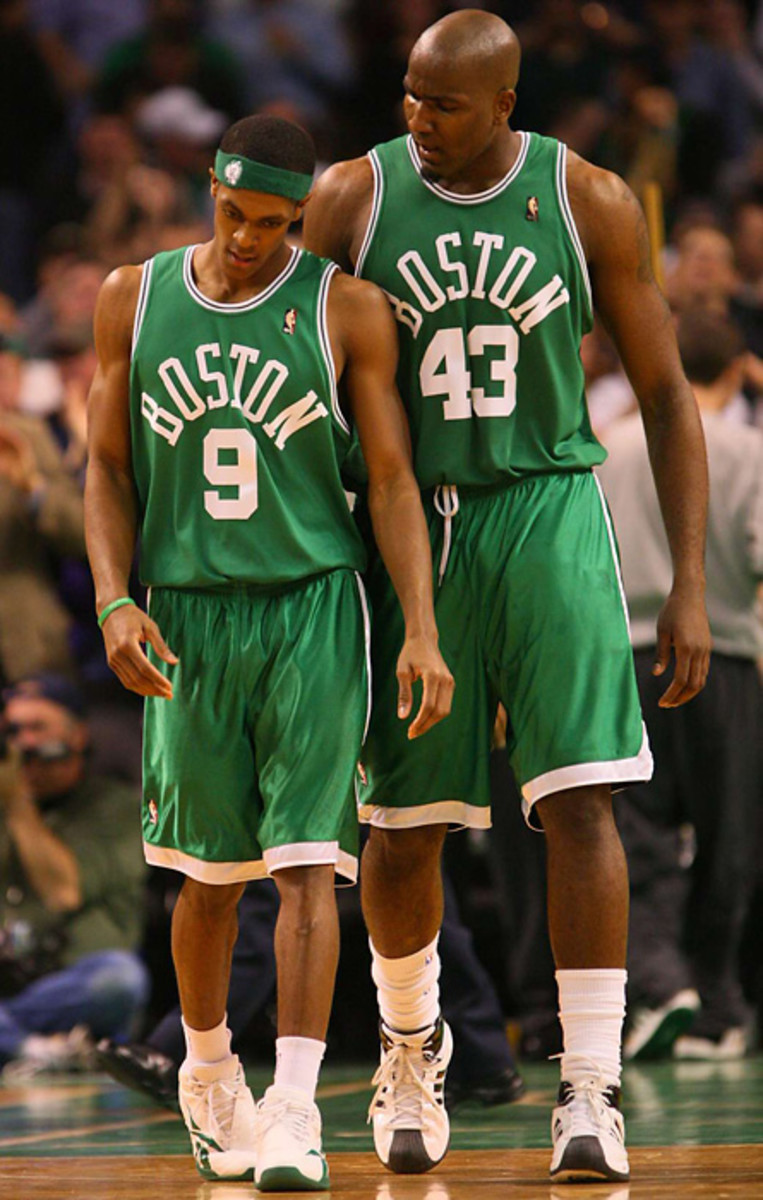
In February 2011, the Celtics traded Kendrick Perkins and Nate Robinson to Oklahoma City in exchange for Jeff Green and Nenad Kristic. The trade hit Rondo hard as Perkins was his best friend on the team. After struggling in the weeks after the trade, Rondo found his groove again in the first round of the playoffs and got a triple-double in Game 3 against the Knicks.
Rondo was suspended three more times as a sophomore, and was also supposed to be banned for a playoff game until a school administrator intervened. "I don't want to play you," Bibby told Rondo. "But they're going to fire me if I don't, and I've got two kids at home." Bibby broke down, and finally, Rondo did as well. He called a tearful team meeting and apologized for putting his coach in an untenable position. He was never suspended again.
Amber worked the 11 p.m.-to-7 a.m. shift at the Philip Morris factory, placing cigarettes in a tray. She never smoked, but when she came home at night, her clothes reeked of tobacco. Early in Rondo's high school career, Philip Morris moved the plant to North Carolina, and Amber thought about uprooting the family. She stayed for her youngest son and landed a job at Frito-Lay. "If we had gone," Rondo says, "I don't know where I'd be right now—maybe jail." Instead he became Bibby's de facto assistant, watching the tapes and formulating the game plans. When Bibby wanted to use a new defense but was too busy washing uniforms to implement it, he explained the scheme over the phone to Rondo, who taught it to the team in the school lobby.
Bibby worried that other coaches would not appreciate Rondo's genius—"You serve steak, but it's on a garbage can," Bibby told him. "Smooth it out"—and when Rondo enrolled for his senior year at famed Oak Hill Academy in Mouth of Wilson, Va., his new roommate thought he was standoffish. Then Josh Smith discovered the merits of living with a basketball savant. "My field goal percentage went way up," says Smith, now a star forward for the Hawks. "I remember one night he had 29 assists, and the next night he had 31. It was like playing with Michael Vick, and I was the only guy who could catch his passes."
Rondo's searing intensity is easily attributed to the predictable slights: Louisville coach Rick Pitino recruited Sebastian Telfair over him. Kentucky coach Tubby Smith marginalized him in a slowpoke offense. He fell to No. 21 in the draft. But Rondo doesn't manufacture motivation. His edge is organic. "I know some guys hold on to that stuff and use it as fuel," he says. "I just want to win." He entered training camp in 2006 as the Celtics' third point guard, behind Telfair and Delonte West, and their first workout included a pick-and-roll drill. "Come on, Rondo, pick it up!" Rivers shouted. "Turn the corner! Be aggressive!" Five straight times he split the double team or turned the corner and scored. "Twenty-first pick?" players asked each other.
After wrongful felony conviction, NBA hopeful gets assist on fulfilling dream
The relationship between point guard and coach is as complicated as that of husband and wife, and even more so if that coach used to be a point guard. When Boston teamed Ray Allen and Garnett with Pierce in 2007, the veterans rarely hung out with Rondo on the road but couldn't stop talking to him on the court. "Everybody was asking for the ball," Rondo says. "I had to keep track of all their shots. It was like, Paul has 17, and Ray only has seven, so I better get it to Ray. I got cussed out a few times." Rivers, who had to satiate Dominique Wilkins, Moses Malone and Reggie Theus as a young point guard in Atlanta, tried to counsel him. "Scorers want to touch the ball," Rivers advised. "Throw it to them and make them throw it back. In the fourth quarter you want everybody feeling good."
Rondo and Rivers engaged in so many sideline debates they should have installed lecterns by the bench. During one Rivers told Rondo that his teammates hated playing with him. During another Rondo told Rivers, "I'm not mad at you! I'm mad at myself!" Rivers responded, "I don't care who you're mad at. Mad is mad. It's taking you out of games." They coined a mantra—Get past mad—to recite when Rondo is suffering from what Rivers calls "an emotional hijack." In the past year Mount Rondo has erupted at officials, opponents and a cameraman, and his rift with Allen is a major reason the most prolific three-point shooter in NBA history is now in Miami. He also still makes plenty of suggestions in timeouts. On Dec. 21, Boston trailed Milwaukee by three points with 18 seconds left, and the Bucks had the ball. Rivers considered fouling, but Rondo argued that the Celtics should try for the steal. Rivers gave in, and Rondo intercepted a pass by Brandon Jennings, leading to a tying three by Pierce. "But sometimes we go the other way," Rivers says. "And he is much better at moving on."
After that game, which Milwaukee won in overtime, Jennings asked rookie guard Doron Lamb if Rondo had crept into his head. "That's what he does," Jennings says. "He's not like D-Rose or Deron Williams or Tony Parker, who keep you on your toes every night. He'll talk trash and get physical. At one point I thought we were going to fight."
Rondo lives in a Boston suburb—his address, like his jersey, is number 9—with his fiancée, Ashley Bachelor, their five-year-old daughter, Ryelle, and one-year-old son, Rajon Jr. He comes across as warm and genial in a one-on-one conversation, describing the manicures he gets with Ryelle. "He is one of my best friends," says Orlando forward Glen (Big Baby) Davis, a former Celtic. "But on the floor he is a stone-cold killer, trained by Kevin Garnett."
For five years Rondo has seen how Garnett intimidates adversaries—"He'll talk trash and mess a guy up the rest of the game," Rondo says—while buttressing teammates. When Boston faces an elite scorer, Garnett helps off his man so that no one gets embarrassed. When the Celtics are tiring at the end of sprints, Garnett breaks into song, and everybody inhales a second wind. Rondo struggles to sleep after games, watching the replay on TV at 2 a.m. and texting Garnett around four. KG always seems to be awake. "Kevin gives tough love, and some guys can't handle it," says Flip Saunders, who coached Garnett in Minnesota. "The ones who can, become lifelong friends."
The best franchises are families, in that elders care for their heirs, until heirs have to care for their elders. When Boston faces top power forwards, Rondo helps off his man, to protect Garnett. "Kevin Love isn't going to get an open look," he vows. There is pride among the Celtics, often lacking in pro sports, which explains better than any metric how they rallied after Rondo was lost. In light of reports linking Garnett to a handful of contenders, he doubled down on his connection to Boston, insisting he would not waive his no-trade clause. The Celtics have an image to uphold, hard and crusty, so it's comical when they follow Rondo's lead at restaurants and order Shirley Temples. "Waitresses are like, 'What?'" Rondo says. "I feel like I have to add a splash of Patron, and I don't even really drink." He is both product and purveyor of this environment. "Rajon has been bred by the culture we created," Garnett says. "He is carrying on the tradition."
Rondo will spend the next six to nine months chasing Peterson, the new standard for ACL patients, and when he returns, the Celtics will be different. They are learning to rebound and run, with a variety of ballhandlers, instead of always waiting in the backcourt for Rondo. He will be free to score off someone else's pass, if he's willing. "He's the smartest guy in the room," Ainge says, "and the most stubborn." The battle that rages within Rondo will determine how he responds. He is smart enough to recognize the benefit of change and stubborn enough to resist it. The Celtics could always rebuild by trading Rondo and his relatively reasonable $11 million salary, but it is more likely they will trust his ability to adapt and deploy him as a lure for free agents. Rondo doesn't glad-hand anybody but claims to be 7 for 8 as a recruiter, selling targets on the benefits of Doc Rivers and a pure point guard. He is more of a people person than he thinks.
As Rondo finishes lunch and his last Shirley Temple—"I've got to lighten up on these," he says—he remembers that the Celtics are hosting a party for kids the next day on the second floor of their practice facility. The room will be filled with desks, and on each desk will be a Connect Four grid, and Rondo will play anyone who dares. "It'll be fun," he says with a half-smile. "I've got to beat the s--- out of them."
